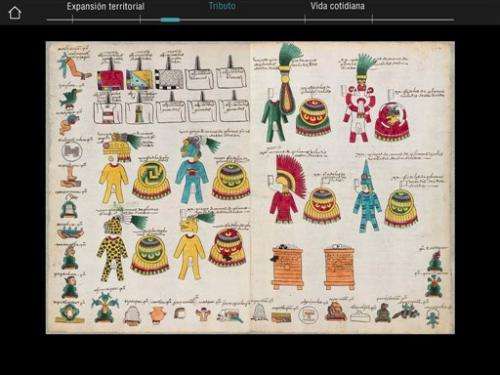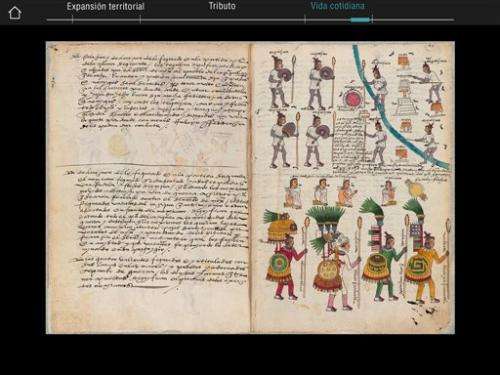Aztec app brings historic Mexico codex into the digital age (Update)

A 16th century document considered one of the most important primary sources on the Aztecs of pre-Columbian Mexico went digital Thursday with a new app that aims to spur research and discussion.
The Codex Mendoza is a 1542 illustrated report ordered by Spanish viceroy Antonio de Mendoza that details sources of riches, Aztec expansion and territorial tributes, and chronicles daily life and social dynamics.
The new interactive codex lets users page through the virtual document, mouse-over the old Spanish text for translations into English or modern Spanish, click on images for richer explanations and explore maps of the area.
Presented by Mexico's National Institute of Anthropology and History, the digital codex is available free both on the Internet and through Apple's App Store as a 1.02-gigabyte app.
"Never before had these tools been used to amplify understanding of a document of these characteristics," said Ernesto Miranda, the institute's director of academic innovation.
The original Codex Mendoza was compiled by Aztec and Spanish artisans to inform the king of Spain about conditions in the viceroyalty. But the boat carrying it to Spain was attacked by French buccaneers and it never reached its destination.
In the mid-17th century it came to be in the collection of University of Oxford, and it has remained there since. Miranda said that until now, Mexican or other researchers who wanted to consult the codex had to track down one of the rare copies, which were only available in English, or make a costly trip to England.

"This is a virtual repatriation" of the document, he said.
"We are in discussions with other European institutions that hold different Mexican codices," Miranda added. "This should be the first of a series."
The National Institute of Anthropology and History created the app in collaboration with Oxford's Bodleian Library and King's College London.
___
Online:
Codex site: codice.manuvo.com
© 2015 The Associated Press. All rights reserved.



















